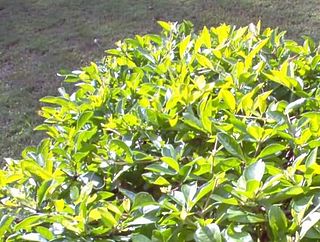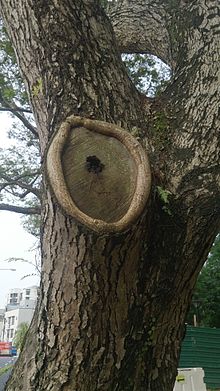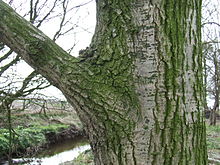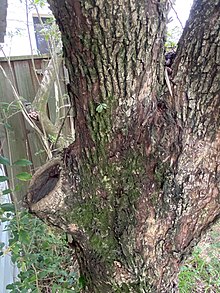
Fruit tree pruning is the cutting and removing of selected parts of a fruit tree. It spans a number of horticultural techniques. Pruning often means cutting branches back, sometimes removing smaller limbs entirely. It may also mean removal of young shoots, buds, and leaves.

Fire blight, also written fireblight, is a contagious disease affecting apples, pears, and some other members of the family Rosaceae. It is a serious concern to apple and pear producers. Under optimal conditions, it can destroy an entire orchard in a single growing season.

Arboriculture is the cultivation, management, and study of individual trees, shrubs, vines, and other perennial woody plants. The science of arboriculture studies how these plants grow and respond to cultural practices and to their environment. The practice of arboriculture includes cultural techniques such as selection, planting, training, fertilization, pest and pathogen control, pruning, shaping, and removal.

An arborist, tree surgeon, or arboriculturist, is a professional in the practice of arboriculture, which is the cultivation, management, and study of individual trees, shrubs, vines, and other perennial woody plants in dendrology and horticulture.

Pruning is a horticultural, arboricultural, and silvicultural practice involving the selective removal of certain parts of a plant, such as branches, buds, or roots.

Girdling, also called ring-barking, is the circumferential removal or injury of the bark of a branch or trunk of a woody plant. Girdling prevents the tree from sending nutrients from its foliage to its roots, resulting in the death of the tree over time, and can also prevent flow of nutrients in the other direction depending on how much of the xylem is removed. A branch completely girdled will fail and when the main trunk of a tree is girdled, the entire tree will die, if it cannot regrow from above to bridge the wound. Human practices of girdling include forestry, horticulture, and vandalism. Foresters use the practice of girdling to thin forests. Extensive cankers caused by certain fungi, bacteria or viruses can girdle a trunk or limb. Animals such as rodents will girdle trees by feeding on outer bark, often during winter under snow. Girdling can also be caused by herbivorous mammals feeding on plant bark and by birds and insects, both of which can effectively girdle a tree by boring rows of adjacent holes.

In trees, heart rot is a fungal disease that causes the decay of wood at the center of the trunk and branches. Fungi enter the tree through wounds in the bark and decay the heartwood. The diseased heartwood softens, making trees structurally weaker and prone to breakage. Heart rot is a major factor in the economics of logging and the natural growth dynamic of many older forests. Heart rot is prevalent throughout the world affecting all hardwood trees and can be very difficult to prevent. A good indication of heart rot is the presence of mushrooms or fungus conks on the tree.

Diplodia tip blight, also known as Sphaeropsis blight, is a widespread disease affecting conifers caused by an opportunistic fungal pathogen, Diplodia sapinea. It is found in “both hemispheres between the latitudes 30° and 50° north and south". The diseases symptoms include: damping off and collar rot of seedlings, stem canker, root disease, and, most commonly, shoot blight. These symptoms have caused significant economic loss to nurseries and pine plantations. In a nursery in the north-central United States, losses of 35% have been reported. Shoot blight and eventual die back can cause a reduction of marketable volume in timber by 63%. Infection of terminal shoots can result in dead-top which significantly limits the usable length of the tree trunk. The presence of the pathogen in concert with severe weather conditions can lead to extreme loss. Following a severe hailstorm in South Africa, nearly 5,000 acres of pine plantation were infected with Diplodia tip blight. It was necessary to prematurely harvest large swaths of the plantations resulting in a loss of 45%. Areas that were not harvested prematurely still suffered an average timber loss of 11%.
Tree topping is the practice of removing whole tops of trees or large branches and/or trunks from the tops of trees, leaving stubs or lateral branches that are too small to assume the role of a terminal leader. Other common names for the practice include hat-racking, heading, rounding over, and tipping. Some species of trees are more likely to recover from topping than others. There are alternatives to topping that can help to achieve the same goals without damaging trees.
Leptosphaeria coniothyrium is a plant pathogen. It can be found around the world.

Nectria cinnabarina, also known as coral spot, is a plant pathogen that causes cankers on broadleaf trees. This disease is polycyclic and infects trees in the cool temperate regions of the Northern Hemisphere. N. cinnabarina is typically saprophytic, but will act as a weak parasite if presented with an opportunity via wounds in the tree or other stressors that weaken the tree's defense to the disease. A study published in 2011 showed that this complex consists of at least 4 distinct species. There are only a few ways to manage this disease with techniques such as sanitation and pruning away branches that have the cankers. N. cinnabarina is not as significant a problem as other Nectria spp., some of which are the most important pathogens to infect hardwood trees.

Anisogramma anomala is a plant pathogen that causes a disease known as Eastern filbert blight on Corylus spp. (hazlenut). Also known as EFB.
The plant pathogenic fungus Leucostoma kunzei is the causal agent of Leucostoma canker, a disease of spruce trees found in the Northern Hemisphere, predominantly on Norway spruce and Colorado blue spruce. This disease is one of the most common and detrimental stem diseases of Picea species in the northeastern United States, yet it also affects other coniferous species. Rarely does it kill its host tree; however, the disease does disfigure by killing host branches and causing resin exudation from perennial lesions on branches or trunks.
Eutypella canker is a plant disease caused by the fungal pathogen Eutypella parasitica. This disease is capable of infecting many species of maple trees and produces a large, distinguishable canker on the main trunk of the tree. Infection and spread of the disease is accomplished with the release of ascospores from perithecia. Therefore, the best way to manage the Eutypella canker is to remove trees that have been infected. If infected, it can decrease the quality of wood cut for lumber and can thus have a negative economic impact.

In woody plants, a tylosis is a bladder-like distension of a parenchyma cell into the lumen of adjacent vessels. The term tylosis summarises the physiological process and the resulting occlusion in the xylem of woody plants as response to injury or as protection from decay in heartwood. It is a key process in wall one of the compartmentalization of decay in trees (CODIT) and other woody plants.
Leucostoma canker is a fungal disease that can kill stone fruit. The disease is caused by the plant pathogens Leucostoma persoonii and Leucostoma cinctum (teleomorph) and Cytospora leucostoma and Cytospora cincta (anamorphs). The disease can have a variety of signs and symptoms depending on the part of the tree infected. One of the most lethal symptoms of the disease are the Leucostoma cankers. The severity of the Leucostoma cankers is dependent on the part of the plant infected. The fungus infects through injured, dying or dead tissues of the trees. Disease management can consist of cultural management practices such as pruning, late season fertilizers or chemical management through measures such as insect control. Leucostoma canker of stone fruit can cause significant economic losses due to reduced fruit production or disease management practices. It is one of the most important diseases of stone fruit tree all over the world.

Phomopsisblight of juniper is a foliar disease discovered in 1917 caused by the fungal pathogen Phomopsis juniperovora. The fungus infects new growth of juniper trees or shrubs, i.e. the seedlings or young shoots of mature trees. Infection begins with the germination of asexual conidia, borne from pycnidia, on susceptible tissue, the mycelia gradually move inwards down the branch, and into the main stem. Management strategies mainly include removing and destroying diseased tissue and limiting the presence of moisture on plants. Junipers become resistant to infection as they mature and the young yellow shoots turn dark green. Preventive strategies include planting only resistant varieties and spraying new growth with fungicide until plants have matured.

A tree fork is a bifurcation in the trunk of a tree giving rise to two roughly equal diameter branches. These forks are a common feature of tree crowns. The wood grain orientation at the top of a tree fork is such that the wood's grain pattern most often interlocks to provide sufficient mechanical support. A common "malformation" of a tree fork is where bark has formed within the join, often caused by natural bracing occurring higher up in the crown of the tree, and these bark-included junctions often have a heightened risk of failure, especially when bracing branches are pruned out or are shaded out from the tree's crown.

Hypoxylon canker of shade trees is a weak ascomycete fungus that negatively affects growth and can eventually lead to the death of weak or diseased host trees. There are many different species that affect different trees. For example, Hypoxylon atropunctatum, a common species, is found on oak trees, Hypoxylon tinctor affects sycamore trees, and Hypoxylon mammatum infests aspen trees.
A branch attachment is where a branch is attached to the trunk of a tree. Three types of branch attachment are recognized due to differences in the anatomical position of buds that form them. Two key components contribute to the mechanical strength and toughness of the attachment: interlocking wood grain at the top of the attachment and an embedded knot that often lies within the attachment. A common malformation of a branch attachment is the inclusion of bark within the join, which can weaken the attachment.



















